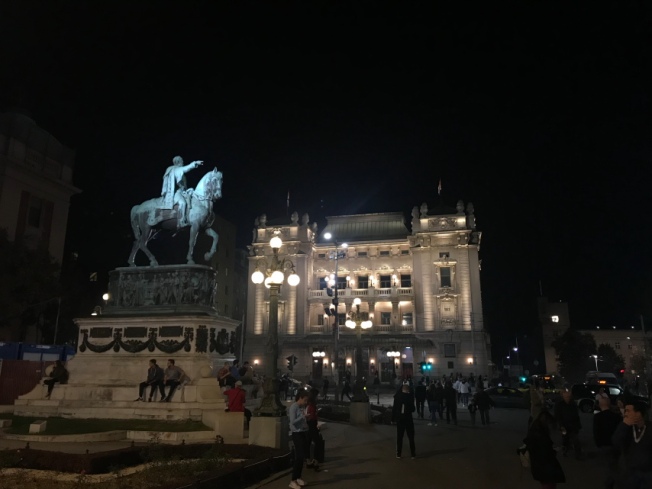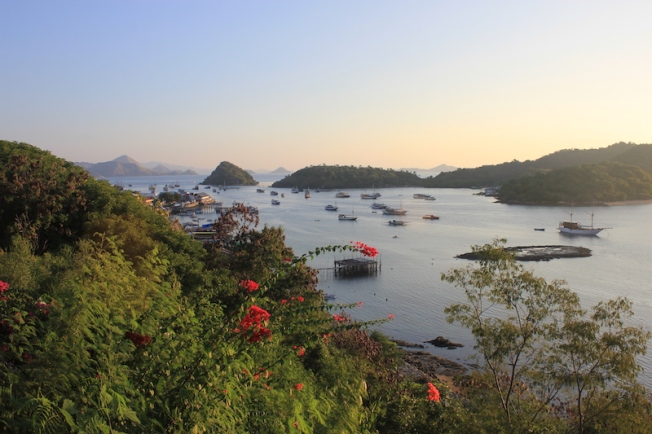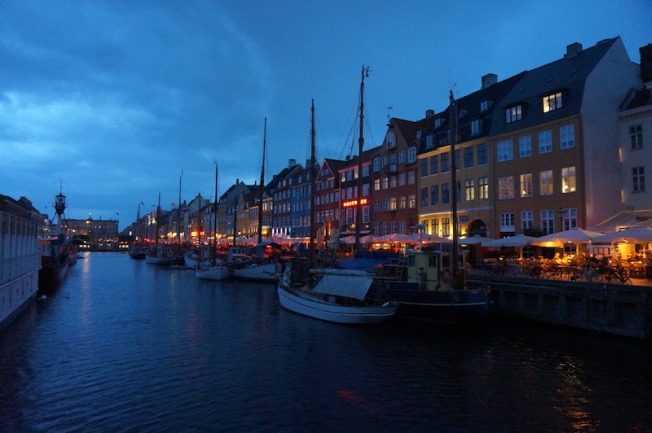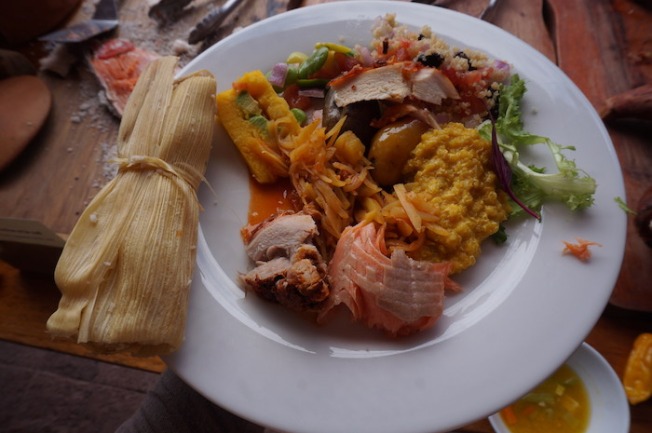On World Gorilla Day (24 Sep), ANURAG MALLICK and PRIYA GANAPATHY relive their encounter with mountain gorillas in Rwanda’s Volcanoes National Park while attending the 14th Kwita Izina or naming ceremony of baby gorillas

Rwanda is undoubtedly one of the best places in the world to spot the endangered gorilla. With direct flights by Rwand Air from Mumbai to Kigali, it’s easy to explore this pocket-sized country in East Africa. Based in the plush Marriott Kigali Hotel in the diplomatic enclave of Kiyovu, we traipsed around the Rwandan capital on a Go Kigali city tour. The gorilla statue near the City Hall was unmissable, and every time we crossed it while visiting local markets and museums, it heightened the anticipation of our encounter with the Silverback.
It was still dark when we set off on a serpentine drive to the misty Volcanoes National Park. Five of the eight volcanoes of the Virunga Mountains – Muhabura, Gahinga, Sabyinyo, Bisoke (with a crater lake) and Karisimbi, the tallest at 4500m – were located in Rwanda on its eastern border with Uganda and Democratic Republic of Congo (DRC). The slopes of the 160 sq km Virunga Massif are the last refuge of the mountain gorilla, one of the two sub species of the eastern gorilla. The park had survived human resettlement, deforestation, bifurcation, poaching and civil war.

In 1967, it became a base for American naturalist Dian Fossey who set up the Karisoke Research Centre and single handedly saved the gorillas from extinction by drawing international attention to their cause. By 1981, due to civil strife and poaching, mountain gorilla numbers in this tri-junction had plummeted to an all time low of 242. Dian was murdered by poachers in 1985 and her life was immortalized in the film ‘Gorillas in the Mist’, named after her autobiography.
She was buried in the park close to the research center, amongst the very gorillas that were her life’s mission. Karisoke remains the longest running gorilla field study site dedicated to the conservation, protection and study of gorillas and their habitats in Africa. 2017 marked 50 years of it, when World Gorilla Day was first constituted.

On reaching the park headquarters at Kinigi near Musanze we were divided into groups of eight before being assigned to one of the twelve gorilla trekking routes open to tourists. Our comfort at tackling previous hikes to the forest canopy walkway and the waterfall at Nyungwe National Park got us slotted on the tougher Isimbi trail. Gaiters, rain jackets and gloves were offered on hire as our 26 year-old guide Jolie briefed us on gorilla behaviour.
We drove beyond Sashwara, past small villages with bustling markets and streets where kids waved, smiled and chanted muzungu meaning ‘foreigner’ in local Kinyarwanda. The Umusumba Trekking Trail began at the edge of the forest, where a troupe of porters in blue uniforms awaited us with beautiful walking sticks carved with gorilla heads. Before we set off, Jolie gave us a crash course on the various grunts, calls and gestures of gorilla language, warning us on how to approach them and be submissive. Our hearts thrummed in excitement…

The two-hour hike along the lower slopes of Karisimbi took us through a thick carpet of sodden bamboo leaves and a tangle of vines. Slipping and tripping through an obstacle course of fallen bamboo, squelchy pathways and dense undergrowth, we practically crawled on all fours at some points. Clearly, to track a gorilla, we had to become gorillas!
We reached our advance party of trackers who had identified their location slightly off-course, forcing us to hack our way through a near impenetrable maze towards steep inclines overridden with stinging nettle. Our hands smarted with the sharp burn as we inadvertently clutched at them to avoid losing balance.

And then suddenly, we stumbled upon the black furry mass of the 19-strong Isimbi family – they were lolling on a bed of stinging nettles as if it were a cloud of silk cotton. Watching over the ten juveniles and eight females was the mighty Muturengere, the alpha male. He was a Silverback, named after the silvery band on the back of mature adult males.
The tiny tots played ball with wild fruits, somersaulted and tumbled around before noticing us. Slowly they approached us with infantile curiosity and we were instructed to step back. Crouching low, we repeated ‘Maaae-mmmmhh’, which meant ‘we come in peace’ until Muturengere relented and grunted his approval.

One of the five biggest Silverbacks in the Virunga massif, he weighed over 200 kg and stood at 1.9m. Seeing him face to face barely a few meters away was spine tingling. A few adolescents nibbled away at leaves as older females nit-picked and groomed their offspring, some monkeyed around and drew nearer to us in mock menace, beating their chests like King Kong.
It was unforgettable and definitely one of the highlights in Rwanda. The allocated hour to spend time with the gorillas went by in a blur. As we headed down the slope of the volcano, the fog rolled in and the feathery image of gorillas in the mist was imprinted in our minds forever.

The afternoon was spent at the gorilla guardian village of Iby’Iwacu for a cultural tour of brewing banana beer, basket weaving, music and food tasting experiences. We met former poachers who were now the park’s custodians. Two days later, we returned to Kinigi for Kwita Izina, a reenactment of the centuries old Rwandan tradition of giving a name to the newborn.
Launched in 2005, Kwita Izina 2018 celebrated the naming of 23 gorillas born in the past year. The numbers were growing each year! The massive gathering at the base of Volcanoes National Park wore a festive air with locals waving Rwandan flags and volunteers dancing and chanting.

A giant gorilla frame made of bamboo with an infant riding on its back served as the backdrop for performances by cultural troupes and South African pop duo Mafikizolo. The 23 celebrity namers from across the world included diplomats, philanthropists, wildlife promoters, statesmen and sports stars who had turned up in Rwandan attire.
Chinese travellers Xinyu Zhang and Hong Liang, who built a gorilla sculpture using 3000 energy saving bulbs, named a baby gorilla from the Igisha family Urugero (example). Rao Hongwei, Chinese Ambassador to Rwanda, gave his baby gorilla two names – one in Kinyarwanda, Uburumbuke (prosperity) and the other in Chinese, Wangwang, drawing much mirth from the crowds.
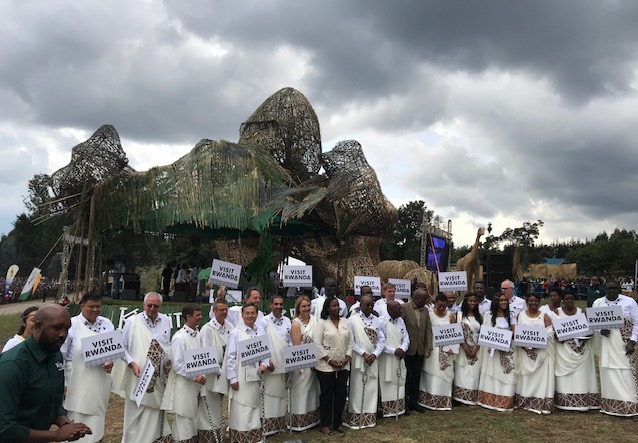
Rwanda Development Board, the nodal agency for investment and tourism, had teamed up with Arsenal Football Club to promote Rwanda. Cameroonian footballer and Arsenal legend Laureno Bisan Etamé-Mayer named his baby gorilla from the Kwitonda family Ikipe (team) while his gorgeous counterpart, Arsenal star Alexandra Virina Scott named her infant from Isimbi family Izahabu (gold).
US Ambassador Peter Vrooman recounted his ascent of Mount Karisimbi and Bisoke and named Susa family’s newborn Intarutwa (paramount). His Highness Sheikh Dr Abdul Aziz Ali Bin Rashid Al Nuami, better known as the ‘Green Sheikh’ named his baby from the Agashya family, Nayombi (exceptional care). It was fascinating to learn from the personal insights and anecdotes, the relevance and context to each name.

Michael Wale, CEO of Kerzner International which runs Atlantis and luxe resorts around the globe (including two One & Only resorts in Rwanda – Gorilla’s Nest and Nyungwe House). When he visited Rwanda four years ago he found it a paradise; hence his name for the little gorilla from the Muhoza family was Paradizo! Mantis, a family-run collection of eco hotels in Africa, manages Akagera Game Lodge in Rwanda.
Founder-chairman Adrian Gardiner has been visiting Rwanda for 11 years and was amazed at Rwanda’s cleanliness and President Paul Kagame’s commitment to the environment. Lauding Rwanda as the ‘University of Africa’ we could all learn from and the symbol of gorilla tourism in the world, the little one from the Musilikare family was named Iribero (symbol). Thomas Krulis of Lotto Investments shared how he witnessed the birth of a baby gorilla before his very eyes while trekking on 16 July 2017 (the second time it had ever happened). His name for the Sabiyani family newborn, Ruhire (lucky) seemed perfect!

We felt a connection when the unnamed mischievous fellas from the Isimbi family we had spotted earlier got baptized! Alexa Gray of Gordon and Patricia Gray Animal Welfare Foundation named her Isimbi newborn Kunesha (to win). Michael O’Brien-Onyeka from Conservation International for Africa reiterated mankind’s dependence on nature and how Rwanda gets it right with leadership, good governance, women empowerment and conservation.
“We feel proud to be African. Since Rwanda has become the sunrise in Africa, I give the name Umuseke (dawn),” the crowds roared. Dr Olusegun Obasanjo, former president of Nigeria lauded Rwanda for devising such a unique and instructive event for raising awareness that was worthy of emulation. He named a newborn Musmikare (May he live long).

The namers included local heroes like porter Judith Kakuze, who called the Amahoro family infant Indakemwa (integrity). Pop stars Theo Kgosinkwe and Nhlanhla Nciza of South African band Mafikizolo thanked Rwanda for protecting nature, forests and the gorillas, naming their Agashya family newborn Ikiza (goodness).
Zimbabwean entrepreneur and philanthropist Strive Masiyiwa admired the Rwandan spirit, naming the newborn from Kwitonda family Ishusho (image), “since Rwanda has become the image of positive change we want to see in Africa.” The star namers held up ‘Remarkable Rwanda’ placards as drummers and costumed Intore dancers stole the show. The event ended on a high with a gala dinner and performance by Mafikizolo at Lake Kivu Serena Hotel.

While we have attended our share of naming ceremonies of cute little babies in India, being present at one for gorillas, was definitely a first! It was truly remarkable to see how a country coming to grips with genocide in the late 90’s had become a role model for the world.
Kwita Izina was easily the most important conservation event in Rwanda – a celebration of the majestic mountain gorillas, park rangers, guides, local communities and 18,000 Rwandans who live around the park who have joined hands with the government in conservation efforts for the past 15 years.

The results spoke for themselves – 50% reduction in gorilla mortality rates, increased visitation by 10% and a 26% increase in the population of mountain gorillas from 480 in 2010 to 604 in 2016. In the 2019 edition of Kwita Izina, 22 baby gorillas were named. Today, mountain gorilla numbers have crossed the magic threshold of a thousand known individuals. And a tiny country like Rwanda was leading the way as a model for sustainable development.
The gorilla groups are tirelessly followed up the steep slopes all year round and the monitoring and research programs of these magnificent creatures and their habitat secures the foundation for future generations. The fact that this is the only region in the world where one can spot them in the wild (they do not survive in captivity) makes it a ‘once-in-a-lifetime’ experience.

FACT FILE
Getting there
The national carrier Rwand Air (www.rwandair.com) flies direct from Mumbai to Kigali (7 hrs) four days a week. From Kigali, Volcanoes National Park is a 3 hr drive away, as are wildlife parks like Akagera and Nyungwe.
Where to Stay
Kigali Marriott Hotel www.marriott.com
Serena Hotels, Kigali & Lake Kivu www.serenahotels.com
Ubumwe Grande Hotel, Kigali www.ubumwegrandehotel.com
Akagera Game Lodge www.mantiscollection.com
Gorilla’s Nest & Nyungwe House www.oneandonlyresorts.com
Gorillas Volcanoes Hotel, Ruhengeri
Visas
Visa on arrival $30. An East African combined visa covering Rwanda, Uganda and Tanzania costs $100.
Entry Fee
Only 96 permits are issued per day with each permit costing $1500
What to Do
Go Kigali City Tour http://gokigalitours.com/
Track gorillas at Volcanoes NP https://www.volcanoesnationalparkrwanda.com
Wildlife tour of Akagera & Nyungwe www.wildlifetours-rwanda.com
Hike to Bisoke (1 day) or Karisimbi, a 2-day trek with overnight camping at 3,800m
For more info, www.visitrwanda.com, www.rdb.rw/kwitizina

Authors: Anurag Mallick & Priya Ganapathy. This article appeared on 20 Sep, 2019 in Indulge, the weekend supplement of The New Indian Express newspaper.






